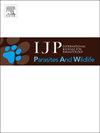丹麦海域斑海豹胃肠道寄生虫的流行、丰度、强度和繁殖潜力
IF 2.2
3区 医学
Q3 ECOLOGY
International Journal for Parasitology-Parasites and Wildlife
Pub Date : 2025-04-01
DOI:10.1016/j.ijppaw.2025.101066
引用次数: 0
摘要
近几十年来,丹麦海域的斑海豹(Phoca vitulina)种群数量显著增加,但其相关的寄生虫种群数量仍然未知。在2024年2月,我们从Limfjorden(丹麦)西部收集了13只海豹,这是一个连接北海和卡特加特海的海洋区域。对这些动物进行了寄生虫学检查(包括形态学和分子方法),证实了该海豹是胃肠道线虫的最终宿主,包括:皮肤收缩线虫、单纯异尖线虫、斑点线虫和蟹贝线虫;所有线虫的流行率均为100%。海豹体内还携带有棘头绦虫(100%流行)和双头绦虫(7.7%流行)。线虫的强度范围为每宿主4 - 1790只,而棘头虫的数量较低(每宿主4 - 222只),一只海豹被3只线虫感染。通过计数雌虫的成熟卵来评价线虫的生殖潜力,结果表明,每只雌虫每天可释放7202 ~ 72810个卵。感染强度显示,一只斑海豹平均每天释放3 × 105个蛋以上。在感染较严重的海豹中,每天释放到环境中的八角鲨卵可能超过2.4 × 106个,每一个卵在孵化和第一个副毒宿主入侵后,对鱼类和人类都有潜在的感染风险。一些茴香类寄生虫对人类消费者具有潜在的传染性,我们讨论了在不同感染水平和海豹种群大小下感染对鱼类和人类的潜在传播。本文章由计算机程序翻译,如有差异,请以英文原文为准。

Gastrointestinal parasites of harbour seal (Phoca vitulina L.) in Danish marine waters: Prevalence, abundance, intensity and reproductive potential
Populations of harbour seal (Phoca vitulina) in Danish marine areas have increased markedly during recent decades, but their associated parasite populations have remained unknown. In February 2024 we collected 13 harbour seals from the western part of Limfjorden (Denmark), a marine area connecting the North Sea with the Kattegat Sea. The animals were subjected to a parasitological examination (including morphological and molecular methods), which confirmed that this seal species acts as a definitive hosts for the gastrointestinal nematodes Contracaecum osculatum s.s., Anisakis simplex, Phocanema decipiens s.s. and P. krabbei; all nematodes were at prevalences of 100 %. The seals also harboured the intestinal acanthocephalan Corynosoma strumosum (100 % prevalence) and the cestode Dibothriocephalus schistochilus (7.7 % prevalence). The nematode intensities ranged from 4 to 1790 individuals per host, whereas acanthocephalans occurred in lower numbers (range 4–222 per host) and a single seal was infected with three cestodes. The reproductive potential of the nematodes was evaluated by counting mature eggs in female worms, which indicated that each of the female worms could release between 7202 and 72,810 eggs per day. Infection intensities revealed that a single harbour seal on average releases more than 3 × 105 eggs per day. In more heavily infected seals, the potential release of anisakid eggs to the environment exceeds 2.4 × 106 eggs per day, each of which, after hatching and invasion of the first paratenic host, represents a potential infection risk for fish and humans. Some of the anisakid parasites are potentially infective to human consumers, and we discuss the potential spread of infection to fish and humans at different infection levels and seal population sizes.
求助全文
通过发布文献求助,成功后即可免费获取论文全文。
去求助
来源期刊

International Journal for Parasitology-Parasites and Wildlife
Medicine-Infectious Diseases
CiteScore
3.80
自引率
5.60%
发文量
113
审稿时长
45 days
期刊介绍:
The International Journal for Parasitology: Parasites and Wildlife (IJP-PAW) publishes the results of original research on parasites of all wildlife, invertebrate and vertebrate. This includes free-ranging, wild populations, as well as captive wildlife, semi-domesticated species (e.g. reindeer) and farmed populations of recently domesticated or wild-captured species (e.g. cultured fishes). Articles on all aspects of wildlife parasitology are welcomed including taxonomy, biodiversity and distribution, ecology and epidemiology, population biology and host-parasite relationships. The impact of parasites on the health and conservation of wildlife is seen as an important area covered by the journal especially the potential role of environmental factors, for example climate. Also important to the journal is ''one health'' and the nature of interactions between wildlife, people and domestic animals, including disease emergence and zoonoses.
 求助内容:
求助内容: 应助结果提醒方式:
应助结果提醒方式:


